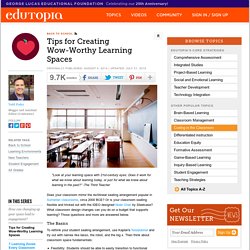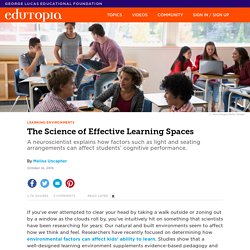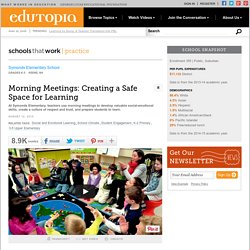

Tips for Creating Wow-Worthy Learning Spaces. "Look at your learning space with 21st-century eyes: Does it work for what we know about learning today, or just for what we knew about learning in the past?”

-The Third Teacher Does your classroom mirror the rectilinear seating arrangement popular in Sumerian classrooms, circa 2000 BCE? Or is your classroom seating flexible and tricked out with the IDEO designed Node Chair by Steelcase? What classroom design changes can you do on a budget that supports learning? Those questions and more are answered below. The Basics To rethink your student seating arrangement, use Kaplan's floorplanner and try out with names like lasso, the robot, and the big x. The Science of Effective Learning Spaces. If you’ve ever attempted to clear your head by taking a walk outside or zoning out by a window as the clouds roll by, you’ve intuitively hit on something that scientists have been researching for years: Our natural and built environments seem to affect how we think and feel.

Researchers have recently focused on determining how environmental factors can affect kids’ ability to learn. Studies show that a well-designed learning environment supplements evidence-based pedagogy and curriculum design. Let’s examine four environmental factors that can enhance or hinder learning. Daytime Light Exposure Can Boost Learning Light does more than just allow us to see the world around us. Even more importantly, all light is not the same.
One study of 21,000 U.S. elementary students showed that, over one school year, kids who were exposed to more sunlight during their school day displayed 26 percent higher reading outcomes and 20 percent higher math outcomes than kids in less sunny classrooms. 1. 7 Learning Zones Every Classroom Must Have. There are many elements to consider as you plan for the next school year.

You always review critical pieces like standards, curriculum, instructional activities, and testing, but you also think about the classroom space and how to arrange desks, set up bulletin boards, and organize materials. You can bring these seemingly disconnected components together in a system of seven classroom zones. Using these zones will help you establish routines, save time, and maintain your sanity from the first through the last days of school. 7 Zones for Optimal Classroom Organization 1.
Share samples of different projects so that students have a jumping-off point. 7 Essential Classroom Zones. The school of the future has opened in Finland. Child psychologists have long argued that changing the approach we take to education would help many children learn to love school rather than hate it.

We’ve all heard pre-schoolers talk about how they can’t wait to sit at their school desk and run to their next lesson with their rucksack over their shoulder. In fact, we probably remember that feeling of excitement ourselves the first time we went. But right from the first days of school, many children feel a huge sense of disappointment with what they encounter. At the Saunalahti school in the city of Espoo, Finland, they’ve found a brilliant way to overcome this problem. Starting just with the school building itself, you’d look at it and never think it was a school. Across its 10,500 square metres, there’s a primary school, a secondary school, a kindergarten, a youth club, theatre, cafeteria, library, gym and many other things. The cafeteria is where both students and teachers meet as part of the learning process. Environment Design.
Sedentism. Morning Meetings: Creating a Safe Space for Learning. Alli: Anybody want to share about how they're feeling today?

Evan, how are you feeling? Evan: Hungry! Alli: You're feeling hungry. Big surprise, right? Owen, how are you feeling today? Owen: I'm feeling sleepy, excited and fine. Alli: Wow, you're feeling lots of emotions today. Definitely noticed a change in some of my shyer students. No matter what kind of morning they had at home, they're going to come into my classroom, they're going to sit in a circle and be with their friends. Molly? Student: And I hope you have a great time. Molly: Thank you. Alli: In order to get any kid to learn, they really have to feel safe. The greeting part of Morning Meeting, it really changes day-to-day. So today I'm going to hand you one card.